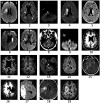Altered brain function during movement programming is linked with motor deficits after stroke: a high temporal resolution study
- PMID: 39188808
- PMCID: PMC11345366
- DOI: 10.3389/fnins.2024.1415134
Altered brain function during movement programming is linked with motor deficits after stroke: a high temporal resolution study
Abstract
Introduction: Stroke leads to motor deficits, requiring rehabilitation therapy that targets mechanisms underlying movement generation. Cortical activity during the planning and execution of motor tasks can be studied using EEG, particularly via the Event Related Desynchronization (ERD). ERD is altered by stroke in a manner that varies with extent of motor deficits. Despite this consensus in the literature, defining precisely the temporality of these alterations during movement preparation and performance may be helpful to better understand motor system pathophysiology and might also inform development of novel therapies that benefit from temporal resolution.
Methods: Patients with chronic hemiparetic post-stroke (n = 27; age 59 ± 14 years) and age-matched healthy right-handed control subjects (n = 23; 59 ± 12 years) were included. They performed a shoulder rotation task following the onset of a stimulus. Cortical activity was recorded using a 256-electrode EEG cap. ERD was calculated in the beta frequency band (15-30 Hz) in ipsilesional sensorimotor cortex, contralateral to movement. The ERD was compared over time between stroke and control subjects using permutation tests. The correlation between upper extremity motor deficits (assessed by the Fugl-Meyer scale) and ERD over time was studied in stroke patients using Spearman and permutation tests.
Results: Patients with stroke showed on average less beta ERD amplitude than control subjects in the time window of -350 to 50 ms relative to movement onset (t(46) = 2.8, p = 0.007, Cohen's d = 0.31, 95% CI [0.22: 1.40]). Beta-ERD values correlated negatively with the Fugl-Meyer score during the time window -200 to 400 ms relative to movement onset (Spearman's r = -0.54, p = 0.003, 95% CI [-0.77 to -0.18]).
Discussion: Our results provide new insights into the precise temporal changes of ERD after hemiparetic stroke and the associations they have with motor deficits. After stroke, the average amplitude of cortical activity is reduced as compared to age-matched controls, and the extent of this decrease is correlated with the severity of motor deficits; both were true during motor programming and during motor performance. Understanding how stroke affects the temporal dynamics of cortical preparation and execution of movement paves the way for more precise restorative therapies. Studying the temporal dynamics of the EEG also strengthens the promising interest of ERD as a biomarker of post-stroke motor function.
Keywords: biomarker; cortical activity; event-related desynchronization; motor control; premovement.
Copyright © 2024 Delcamp, Chalard, Srinivasan and Cramer.
Conflict of interest statement
The authors declare that the research was conducted in the absence of any commercial or financial relationships that could be construed as a potential conflict of interest.
Figures







References
-
- Bigot J., Longcamp M., Dal Maso F., Amarantini D. (2011). A new statistical test based on the wavelet cross-Spectrum to detect time-frequency dependence between non-stationary signals: application to the analysis of Cortico-muscular interactions. NeuroImage 55, 1504–1518. doi: 10.1016/j.neuroimage.2011.01.033 - DOI - PubMed
Grants and funding
LinkOut - more resources
Full Text Sources
Miscellaneous

